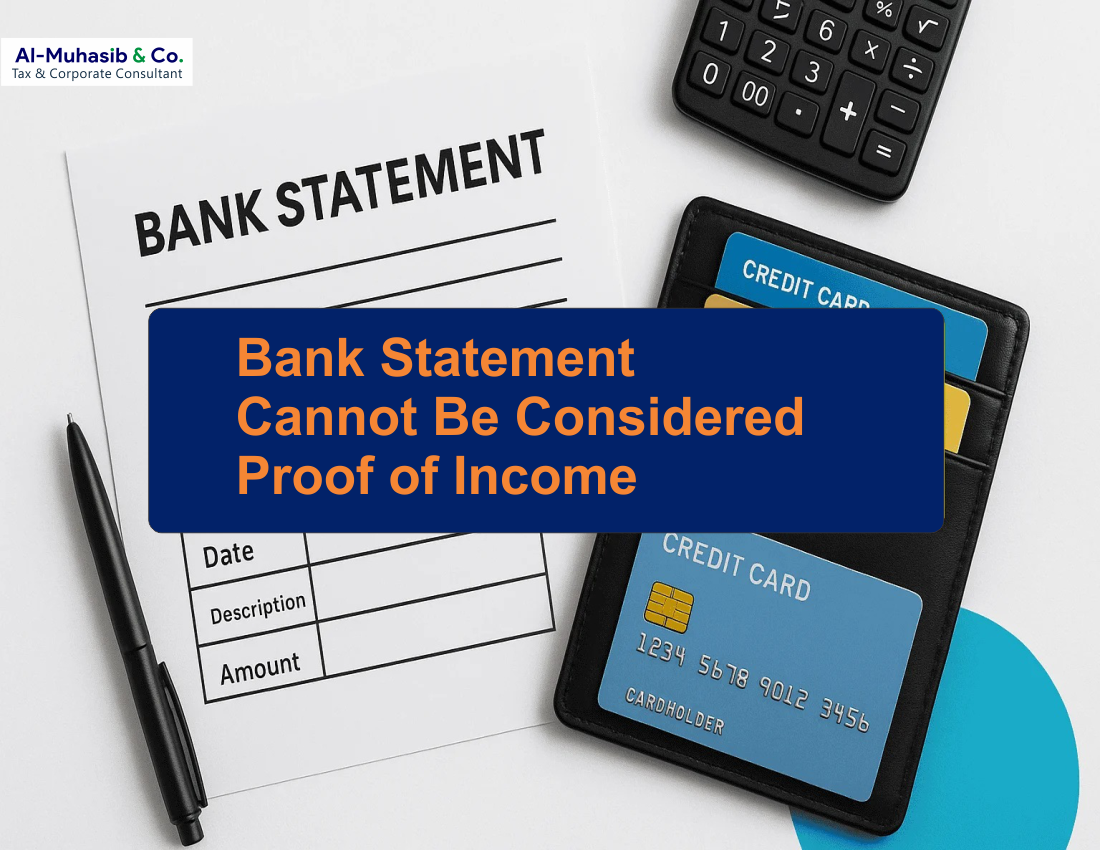Bank Statement alone Cannot Be Considered Proof of Income
Bank statement alone cannot be considered proof of income, according to a recent Supreme Court ruling about bank account transactions. In the past, the FBR generally collected tax by treating the total credits listed in a bank statement as income, but the court has provided clear guidance on this practice.
Key points of the decision
- Bank statement alone cannot be considered proof of income. That is income cannot be declared based on the amount deposited in the account alone. If any amount is deposited in the bank account of a taxpayer, the FBR cannot necessarily consider it as earing.
- The FBR must first prove that the amount coming or credited into the taxpayer account is actually the Earnings.
- Income is categories in to following heads (Salary, Business, Property, Bank Profit and other sources.
- If the amount deposited in the bank account consists of a loan, gift, transfer of own funds from one account to another, or any other item that is not legally taxable, then the FBR cannot impose tax on it.
- The FBR cannot simply aggregate all the amounts deposited in the bank account, treat them as “income” and then impose full tax rate on it, as the revenue authority has done in the present case.
How FBR calculate Tax on Bank Deposits
For example, if a total of Rs 3,280,000 has been deposited in someone’s bank account, out of which only Rs 1,850,000 is salary, which is taxable Earning. The remaining amount, such as loans or self-transferred funds, is not taxable.
In this example, the tax payable on a salary of Rs. 1,850,000 becomes only Rs. 44,500. But if the FBR considers all the credit entries of Rs. 3,280,000 as earnings, the entire amount will be taxed and the total tax liability will be Rs. 373,000.
Bank Statement Alone Cannot Be Considered Proof of Income
Requirements on the FBR
Concrete evidence/clear information or definite information will be required that the relevant credits are income and then FBR impose tax. Only bank entries are not definite information.
In audit/assessment, bank reconciliation and supporting documents may be asked from the taxpayer.
Taxpayer Responsibilities -What to Prepare?
- Make a bank reconciliation with each return:
- Note the total credit (incoming amount) and total debit (outgoing amount) from the bank statement.
- Categorize each credit entry: Income / Loan / Self-transferred amount / Other.
- Attach the receipt/sales agreement/salary slip, etc. for the entry you claim as Earning.
- Attach explanation and evidence (e.g. bank transfer reference, loan agreement, repayment proof) for non-income amounts such as loans/transfers/refunds.
- Finally, make a summary:
- Total credit = X,
- Taxable income = Y
- Non-income amounts = Z (loans/inter-accounts/etc.).
Practical Example (Sample Framework)
Total Credit (for the year): For example, 3,290,000
| Debit | Credit |
Household | 950,000 |
|
Loan | 300,000 | 450,000 |
Own Account transfer | 750,000 | 980,000 |
Salary Transferred |
| 1,800,000 |
Donation | 50,000 |
|
Bonus Received |
| 50,000 |
Bank charges |
|
|
refund/chargeback |
| 10,000 |
| 2,050,000 | 3,290,000 |
Conclusion: Only those amounts will be considered as Earnings which have evidence of nature of earning behind them.
Step-by-step approach during audit/assessment
- If notice is received, prepare statement + reconciliation from the first day.
- Tag each disputed credit:
- Salary/Bonus, Loan (with repayment), Inter-account Transfer etc
- If the officer declares the total credit as income, file a written objection in light of the decision and provide a documentary evidence mere verbal explanation is not enough.
- In case of a loan, prepare a written agreement between the borrower and the lender, while in case of a gift, a gift deed is mandatory. Also, keep in mind that other conditions must be met for a tax-exempt transaction. For example, the loan amount must be transferred through a banking channel, otherwise the transaction will be considered taxable.
FBR current practises
Earlier: The tendency to consider total credits/debits as income.
Now: FBR has to prove it first; mere statement is not enough.
Nature of transaction and evidence are of central importance.
The general rule is that a bank statement alone is not enough evidence is required. But how practical is this? Because the FBR actually has this tool to trace those who are not disclosing their actual earning. Generally, people keep all their savings and earnings in the bank.
So this decision should not be taken to mean that you can do as many bank transactions as you want without hesitation. Caution is still mandatory.
Best Practices to avoid FBR Notices
- Avoid unnecessary transactions (repeated borrowing/returning, pass-through to friends) such actions raise doubts in the audit.
- Wherever possible, maintain a documentary trail of every significant transaction.
- Having a single salary/business account and maintaining a clear narrative makes reconciliation easier.
- Keep reconciliations updated throughout the year, not at the end of the year.
Checklist
Bank statement alone cannot be considered proof of income to avoid FBR. See this checklist.
- Annual bank statement obtained?
- Nature of each credit determined? (Debt/Transfer/Other)
- Evidence attached to each claim?
- Summary sheet prepared? (Total Credit, Taxable Income, Non-Taxable Income)
- Reconciliation packet prepared to be submitted in the event of an audit.
For more information, fill out the Contact Us form on our website or connect with us through our social media accounts.



